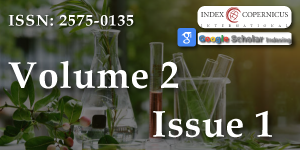Reaction of Psidium guineense and Psidium guajava genotypes to infection of Meloidogyne enterolobii
Main Article Content
Abstract
Psidium guajava (guava) is an important crop and economic resource in many tropical countries and Brazil stands out as one of its major commercial producers. The guava crop has been severely attacked by the plant parasitic nematode Meloidogyne enterolobii which has caused drastic reduction of productivity and, in some cases, even total loss of cultivated areas. The use of resistant rootstocks that are tolerant to these soil pathogens can be a low-cost solution to this pathogen, which has established itself as one of the major constraints for the cultivation of guava in Northeast Brazil. The objective of this work was to evaluate the reaction of P. guajava and P. guineense to M. enterolobii infection under greenhouse conditions, with an infection period of 60 days. 12 P. guineense, and 4 P. guajava were evaluated. The host response to the nematode infection was evaluated according to the following parameters: gill index (GI), reproductive factor (RF), and reduction of reproductive factor (RRF). Considering the RRF criteria, the P. guineense genotypes, AR1, AR3, AR4 and AR10 were considered resistant. The RF index was considered inadequate to evaluate resistance in the 60 days period, due the slow development of the parasite in P.guineense.
Article Details
Copyright (c) 2018 de Moraes Filho RM, et al.

This work is licensed under a Creative Commons Attribution 4.0 International License.
Pereira FM. Nachtigal JC. Melhoramento da goiabeira. In: Cultura da goiabeira: tecnologia e mercado. Rozane, D.E., Couto, F.A.d'A., Eds.; UFV: Viçosa, Brazil. 2003; 53-78.
Narciso N Rodríguez, Juliette Valdés, Julio A Rodríguez, Josefa B Velásquez, Domingo Rivero, et al. Genetic resources and breeding of guava (Psidium guajava L.) in Cuba. Biotecnol Apl. 2010. Ref.: https://goo.gl/eTf5e2
São José AR, Rebouças TNH, Dias NO, Hojo RH, et al. Cultivo de Goiabeira no Brasil. In: Primer Simpósio Internacional de La Guayaba. Memoria Aguascalientes, Aguascalientes. 2003.
IBGE. Produção Agrícola Municipal. 2014. http://www.sidra.ibge.gov.br.
Raseira MCB, Raseira A. Contribuição ao Estudo do Araçazeiro: Psidium cattleyanum. Embrapa-CPACT. 1996; 95. Ref.: https://goo.gl/p7VZh2
Souza RM, Nogueira MS, Lima IM, Melarato M, et al. Manejo de nematoides das galhas da goiabeira em São João da Barra (RJ) e relato de novos hospedeiros. Nematol Bras. 2006; 30: 165-169. Ref.: https://goo.gl/zPRNBQ
Pereira FM, Kavati R. Contribuição da pesquisa científica brasileira no desenvolvimento de algumas frutíferas de clima subtropical. Rev Bras Frutic. 2011; 108. Ref.: https://goo.gl/wqg8xj
Maranhão SR. Reação de indivíduos segregantes de goiabeira e araçazeiro a Meloidogyne spp. e caracterização de populações atípicas do nematoide. Dissertação Mestrado, Universidade Federal de Rural de Pernambuco, Recife. 2001.
Lima IM, Dolinski C, Souza RM. Dispersão de Meloidogyne mayaguensis em goiabais de São João da Barras (RJ) e relato de novos hospedeiros dentre plantas invasoras e cultivadas. Nematologia Brasileira. 2003; 27: 257-258.
Guimarães LMP, Moura RM, Pedrosa EMR. Parasitismo de Meloidogyne mayaguensis em diferentes espécies botânicas. Nematologia Brasileira. 2003; 27: 139-147. Ref.: https://goo.gl/jS87ev
Moreira AA, Martins LSS, Musser RS, Moraes Filho RS, MaranhãoW, et al. Response of Malpighia emarginata active germplasm bank accessions to Meloidogyne enterolobii parasitism. Genetics and Molecular Research. 2016; 15: 15048868. Ref.: https://goo.gl/sTBNRt
Scherer ARG, Carneiro APA, Mônaco MP, Moritz KC, Nakamura JC, et al. Reação de Genótipos de Psidium guajava a Meloidogyne enterolobii. Nematologia Brasileira. 2012; 36: 1-2. Ref.: https://goo.gl/f61PuL
Martins LSS, Musser RS, Souza AG, Resende LV, Maluf WR. Parasitismo de Meloidogyne enterolobii em espécies de Myrtaceae. Revista Brasileira de Fruticultura. 2013; 35: 477-484. Ref.: https://goo.gl/p9t3ve
Biazatti MA, Souza RM, Marinho CSI, Guilherme DO, Campos GS, et al. Resistência de genótipos de araçazeiros a Meloidogyne enterolobii. Ciência Rural.2016; 46: 418-420. Ref.: https://goo.gl/TiUMTa
Sousa ADP, Silva EMR, Castro CUC, Cunha JMC, Ribeiro JM. Penetration, development, and reproduction of Meloidogyne enterolobii on Psidium species and induced cellular responses in the roots. Revista Brasileira de Fruticultura.2017; 39: 453. Ref.: https://goo.gl/jXFPqz
Hussey, R.S.; Barker, K.R. A comparison of methods of collecting inoculated of Meloidogyne spp., including a new technique. Plant Disease Reporter. 1973; 57: 1025-1028. Ref.: https://goo.gl/4DKR9r
Taylor AL, Sasser JN. Biology identification and controlo f root-knot nematodes (Meloidogyne species). Raleigh: North Carolina State University Graphics. 1978; 111. Ref.: https://goo.gl/2ejnXA
Hartman KM, Sasser JN. Identification of Meloidogyne species on the basis of differential host test and perineal-pattern morphology. In: Advanced Treatise on Meloidogyne: Methodology; Barker, K.R, Carter, C.C. & Sasser, J.N. Eds.; Raleigh NC. North Carolina State University, USA. 1985; 2: 69-77. Ref.: https://goo.gl/abRSES
Oostenbrink M. Major characteristic of the relation between nematodes and plants. Wageningen: Medelingen. Landbowhogeschool. 1966; 46. Ref.: https://goo.gl/RnKgif
Moura RM, Régis EMO. Reações de cultivares de feijoeiro comum (Phaseolus vulgaris) em relação ao parasitismo de Meloidogyne javanica e M. incognita (Nematoda: Heteroderidae). Nematol Bras. 1987;11: 215-225.
Silva F de ASE, Azevedo CAV de. The Assistat Software Version 7.7 and its use in the analysis of experimental data. Afr J Agric Res. 2016; 11: 3733-3740. Ref.: https://goo.gl/wErZaE
Miranda GB, Souza RM, Gomes VM, Ferreira TF, Almeida AM. Avaliação de acessos de Psidium spp. quanto à resistência a Meloidogyne enterolobii. Bragantia, Campinas.2012; 71: 52-58. Ref.: https://goo.gl/kCfKaV
Costa Filho JH. Coleta e reação de acessos de melancia a Meloidogyne enterolobii. Mestrado em Fitotecnia, Universidade Federal Rural do Semi-Árido, Mossoró (RN). 2012; 27: 238-241. Ref.: https://goo.gl/sL8D8q
Marques ML, Pimentel SJP, Tavares OCH, Veiga CFM, Berbara RLL. Hospedabilidade de diferentes espécies de plantas a meloidogyne enterolobii no Estado do Rio de Janeiro. Nematropica. 2012; 42: 303-313. Ref.: https://goo.gl/1f2d4H
Pereira KC, Soares PLM, Santos JM dos, Batista ESP, Maldonato WJ. Desenvolvimento de cultivares de goiabeira inoculadas com Meloidogyne enterolobii. Nematropica. 2016; 46: 54-59. Ref.: https://goo.gl/BPCvs8
Carneiro RMDG, Cirotto PA, Silva DB, Carneiro RG. Resistance to Meloidogyne mayaguensis in Psidium spp. accessions and their grafting compatibility with P. guajava cv. Paluma. Fitopatologia Brasileira. 2007; 32: 281-284. Ref.: https://goo.gl/5pNBb4
Castro JMC, Flori JE, Santos CAF, Antunes EF. Evalution of tolerance of Psidium species to the Meloidogyne mayaguensis nematode. In: International Symposium on Guava and other Myrtaceae, Merida, Mexico. 2008; 25. Ref.: https://goo.gl/bdoq2j

